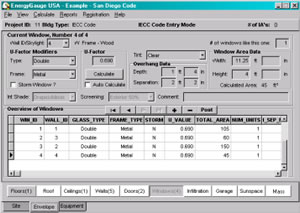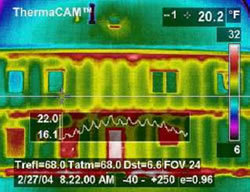|
Figure 11 Completed Dukane
Precast home tested by BAIHP |
FSEC
made a February 2002 site visit to Dukane Precast in Naperville,
Illinois and provided technical design assistance in a
follow-up telephone conference call in March ‘02.
In
2003, Dukane Precast requested BAIHP assistance in the
design phase and monitoring of the first prototype of a
new line of homes called “The Fortified House (Figure
11). Objectives of Dukane’s Fortified House include
energy efficiency, comfort, durability, and good indoor environment
conditions.
In December 2003, FSEC visited 3 prototype buildings in
various stages of construction in. One was complete. Researchers
made recommendations regarding window flashing, below grade
drainage and waterproofing, interior ducts, air sealing,
attic access detail, floor finishes with radiant heating,
radiant heat zoning, ventilation system design and operation.
In
February, FSEC returned to Dukane for testing and infrared
evaluation of 3 completed prototype Fortified Homes built
by Dukane’s sister company,
Mustang Construction at Keller Court, Boilingbrook, IL,
just west of Chicago.
Infrared
images were recorded from the inside and outside during
a calm morning with ambient air temperature of about 25 º F and interior temperatures of about 70 º F,
and whole house air tightness was assessed with a blower
door test. Whole house infiltration was ACH50=1.28 (very
low) 11 Keller Court data (Specifications, Table 11) was
obtained with a multipoint blower door test. IR scans found
no major infiltration pathways.
The ceiling and gable end of the vaulted living room were
built with wood frame construction instead of precast concrete.
Both showed higher heat loss than was generally found in
the precast panels. Flaws in the continuity of ceiling insulation
over the vaulted ceiling were visible from the vented attic.
especially around can lights. The flat ceilings in this home
were insulated with R-38 rigid polyisocyanurate loosely laid
on the concrete ceiling panels. Dukane has now switched to
an R-23 precast panel for ceilings.
Table
11 Dukane Precast’s Fortified Home Specifications |
Component |
Dukane Home |
Conditioned area |
5100 (with basement) |
HERS score |
NA |
Envelope |
Floors and Ceiling |
Precast concrete panels |
Walls |
R-23
(~3") Polyisocyanurate
between precast concrete |
Attic |
Vented with R-38 Polyisocyanurate and
Batt |
Windows |
Insulated glass, vinyl frame, u-value=0.36,
SHGC=0.45 |
Infiltration |
Ach50=1.28 |
Equipment |
Heating |
Radiant floor |
Boiler |
140kBtu, 50 gallon AFUE=92 Gas Boiler |
Cooling |
3 ton, 10 SEER, Unico-type |
Ducts |
High velocity, small ducts, unconditioned
space |
Thermostat |
Programmable |
Ventilation |
Honeywell 150cfm HRV |
Water Heating |
From Boiler |
Opportunities
for Improvement
|
Figure
12 IR-scan
showing metal trusses
in precast walls. Temperature at the crosshairs is 20.2 ° F. Overlaid
temperature graph shows temperature variation of
the surfaces at the white line running horizontally through the crosshairs. |
Infrared scans were performed on the ranch home and two
other homes nearing completion on Keller Court. All three
had the space heating system in operation holding the interior
near 70 F. Initial scans of the exterior clearly showed increased
heat conduction at the truss locations in the precast panels (Figure
12). The metal truss members are cast into the assembly
to connect the interior and exterior panels and allow for
approximately 3 inches of polyisocyanurate foam (R-23). Exterior
infrared scans showed a 2 - 4º F temperature rise at
truss locations; exterior temperatures were between 12º and
24ºF.
Increased heat loss was also visible at the top and bottom
of precast sections where field connections are made during
construction and filled with grout. Each panel has at least
two lifting fasteners imbedded in the top edge for the crane
to connect to during home construction. Foam insulation around
these fasteners is sometimes removed to connect the lifting
hook and the void is re-insulated in the field. Insulation
levels are reduced where precast walls are connected to floors
and ceilings. These areas have one inch of rigid XPS foam
(R-5) next to the outer panel but are otherwise left open
until structural and electrical conduit connections are made
in the field after which they are filled with grout.
Interior Ducts and Moisture Issues
FSEC Researchers met with Dukane Precast staff, their architect
and mechanical contractor to identify a way to incorporate
interior ducts into a new model of the Fortified House. Ducts
are used primarily for cooling and ventilation as all Dukane
Precast homes are designed with in-floor radiant heat driven
by a high efficiency (92 AFUE) boiler. The boiler also provides
domestic hot water in conjunction with a 50-gallon storage
tank.
The main obstacle to building interior ducts was finding
a place to run ducts from the basement mechanical room to
the first and second floors. Agreement was made to run supply
risers near the center of the home and returns in a chase
on an outside. The two-story foyer offers the best placement
for a central return for both the first and second floor
supplies.
Dukane
is currently using a high velocity, small duct air conditioning
system by Unico with 2-inch diameter supply branches that
are easier to fit into walls and chases than low velocity
ducts. One unoccupied home had problems with condensation
accumulating on the attic-mounted ducts. The cause was
traced to humid indoor air contacting cold metal trunk
lines in the vented attic.
No occupant-related moisture was present but the precast
panels, which are still in the process of drying, are one
possible source. Periodic mixing of the indoor air may be
all that is required until moisture output from the panel
is reduced. Otherwise, introducing dry air was recommended
to prevent condensation. Findings and recommendations were
sent of the Dukane Precast in a Trip Report.
- Dye Company and DelAir - Southern Living Home
Florida H.E.R.O. met with Dye Company president
and his staff to discuss the new Southern Living Home planned
for showcase at the 2003 Southeast Building Conference
(SEBC) in Orlando, Florida. This firm has a strong desire
to differentiate their homes by emphasizing healthy and
energy efficient homes. Florida HERO introduced the Building
America systems engineering approach to the builder and
subsequent discussions resulted in Dye’s commitment
to partner with Building America in this project. As a
result, researcher met with DelAir mechanical contracting
to discuss the development of mechanical specifications
for the Southern Living project.
This home did have a Honeywell ERV added and had a HERS
score of 88.5. While this home did not meet the BA standard
of performance for the 2003 SEBC show, retrofits are being
completed with the anticipation that it will be a BA home.
The 2004 home achieved a HERS of 89.6. Both homes have unvented
attics with ducts in conditioned space, and used heat pumps
with SEERs ranging from 13.5 - 14.1. Windows in the 2004 home
have a SHGC of .29 and gas (LP) instant hot water heaters were
used.
 |
Figure
13 Window input
screen from EnergyGauge USA home energy rating
and
simulation software |
This software uses the hourly DOE 2.1E engine with FSEC
enhancements and a FSEC-designed user friendly front end
to calculate home energy ratings and energy performance. (Figure
13) Researchers continue to improve the software’s
features and accuracy. Version 2.0 incorporates many enhancements,
which may include multiple zones, multi-fuel use, and a detailed
solar thermal and solar electric system analysis. For more
information, please visit www.energygauge.com.
In 2002, researchers visited four Fleetwood factories in
southern Georgia to investigate the cause of moisture-related
building failures when units were installed in a hot-humid
climate. The factories are located in Douglas, Alma, Pearson,
and Willacootche. As a result of FSEC recommendations, the
factories have changed their duct construction practices
and are now constructing airtight ducts with mastic.
Six
Fleetwood homes, all in Florida, were tested for moisture
and mold damage from April 2002 through March 2003. All
of the homes had damaged flooring due in part to a lack
of ground cover and poor crawlspace ventilation. Damage
to the floor in one home was exacerbated by a plumbing
leak. Only one home had moisture damage to the wallboard
material, and this home showed a history of thermostat
settings below 72° F.
A report for each home was submitted to Fleetwood for corrective
measures. One additional high bill complaint in Cobb, Georgia
was investigated during that period. Between April 2003 and
March 2004 eight Fleetwood moisture damaged homes were investigated
by BAIHP, seven in Florida and one in Texas.
In May 2003, FSEC researchers were asked by Fleetwood and
Coleman to travel to Fleetwood's five southeastern plants
and test three homes built by each factory to get their plants
certified for building EnergyStar Homes. A sample of the
data collected is shown in Table 12.
Table
12 Test Results, Factory Certification at Fleetwood’s
Auburndale facility |
House
# |
Size |
ACH50 |
Estimated
natural ach (ACH50/18) |
Qn
total
(CFM25
total/ cond. area)
|
1 |
24 X 48 |
8.7 |
0.48 |
0.031 |
2 |
28 X 52 |
5.5 |
0.31 |
0.034 |
3 |
28 X 52 |
5.5 |
0.31 |
0.029 |
At the Auburndale, FL plant, BAIHP researchers conducted
the tests in houses set up in the factory's parking lot.
The houses did not have air handlers, but total duct leakage
was within range to achieve Fleetwood's goal for this plant
which was to build houses according to the EPA EnergyStar
Building Option Packages (BOPs) for manufactured housing,
Climate Zone 4, and to attain a less than 5% duct leakage
rate (Qn,total #5%). The houses showed some need for additional
envelope sealing which was implemented after the first house
was tested. The other two houses showed marked improvement
in whole house air tightness. Recommendations and test results
were provided to Fleetwood via email (no formal trip report).
Similar testing was conducted at the Georgia Fleetwood factories
in Willacoochee, Pearson, Douglas, and Alma.
|


 You
are here:
You
are here: 

